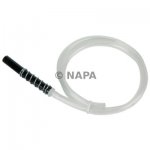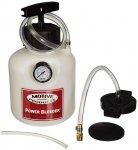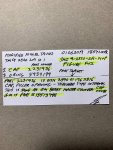Some of the attached may help
This is my best files on the subject and it belongs in here due to the title.
View attachment DOT 3 Dot 5 brake fluid 01042018 pro.docxView attachment DOT 5 MIL-PRF-46176B[1].pdfView attachment DOT brake fluid secrets.pdfView attachment TB43-0002-87 replacement procedure brake fluid.pdf
The TB 43-0002-87 02051982 is probably what you need to comply with but since I was searching thru 12GB of files I put the other attachments here into SS so they don't get "lost".
View attachment DOT brake fluid secrets.pdf
.........and NO, I do not know why I see just big black boxes or just little white boxes but click on it and it should work, haven't figured that one out yet. Also I would attach my own .DOCX file here for brevity but that is disallowed so here is copy paste. fm
Battle of the Brake Fluid DOTs
DOT 3-4 Verses DOT 5. Which brake fluid should I use? {Dot 5.1 has nothing to do with this}
From Oak Okleshen #35 "With regards to the DOT 3-4 verses DOT 5 brake fluid controversy, here is an article sent to me by Mr. Steve Wall. It is one of the most professional treatments I have seen on the subject".
[I had to condense this article from 6 pages to 1 due to space limitations – [fm]
Brake Fluid Facts
by Steve Wall
As a former materials engineering supervisor at a major automotive brake system supplier, I feel both qualified and obligated to inject some material science facts into the murky debate about DOT 5 verses DOT 3-4 brake fluids. The important technical issues governing the use of a particular specification brake fluid are as follows:
1. Fluid compatibility with the brake system rubber, plastic and metal components.
2. Water absorption and corrosion.
3. Fluid boiling point and other physical characteristics.
4. Brake system contamination and sludging.
Additionally, some technical comments will be made about the new brake fluid formulations appearing on the scene.
First of all, it's important to understand the chemical nature of brake fluid. DOT 3 brake fluids are mixtures of glycols and glycol ethers. DOT 4 contains borate esters in addition to what is contained in DOT 3. These brake fluids are somewhat similar to automotive anti-freeze (ethylene glycol) and are not, as Dr. Curve implies, a petroleum fluid. DOT 5 is silicone chemistry.
Fluid Compatibility
Brake system materials must be compatible with the system fluid. Compatibility is determined by chemistry, and no amount of advertising, wishful thinking or rationalizing can change the science of chemical compatibility. Both DOT 3-4 and DOT 5 fluids are compatible with most brake system materials except in the case some silicone rubber external components such as caliper piston boots, which are attacked by silicon fluids and greases.
Water absorption and corrosion
The big bugaboo with DOT 3-4 fluids always cited by silicone fluid advocates is water absorption. DOT 3-4 glycol based fluids, just like ethylene glycol antifreezes, are readily miscible with water. Long term brake system water content tends to reach a maximum of about 3%, which is readily handled by the corrosion inhibitors in the brake fluid formulation. Since the inhibitors are gradually depleted as they do their job, glycol brake fluid, just like anti-freeze, needs to be changed periodically. Follow BMW's recommendations. DOT 5 fluids, not being water miscible, must rely on the silicone (with some corrosion inhibitors) as a barrier film to control corrosion. Water is not absorbed by silicone as in the case of DOT 3-4 fluids, and will remain as a separate globule sinking to the lowest point in the brake system, since it is more dense.
Fluid boiling point
DOT 4 glycol based fluid has a higher boiling point (446F) than DOT 3 (401F), and both fluids will exhibit a reduced boiling point as water content increases. DOT 5 in its pure state offers a higher boiling point (500F) however if water got into the system, and a big globule found its way into a caliper, the water would start to boil at 212F causing a vapor lock condition [possible brake failure -ed.]. By contrast, DOT 3 fluid with 3% water content would still exhibit a boiling point of 300F. Silicone fluids also exhibit a 3 times greater propensity to dissolve air and other gasses which can lead to a "spongy pedal" and reduced braking at high altitudes.
DOT 3 and DOT 4 fluids are mutually compatible, the major disadvantage of such a mix being a lowered boiling point. In an emergency, it'll do. Silicone fluid will not mix, but will float on top. From a lubricity standpoint, neither fluids are outstanding, though silicones will exhibit a more stable viscosity index in extreme temperatures, which is why the US Army likes silicone fluids. Since few of us ride at temperatures very much below freezing, let alone at 40 below zero, silicone's low temperature advantage won't be apparent. Neither fluids will reduce stopping distances.
With the advent of ABS systems, the limitations of existing brake fluids have been recognized and the brake fluid manufacturers have been working on formulations with enhanced properties. However, the chosen direction has not been silicone. The only major user of silicone is the US Army. It has recently asked the SAE about a procedure for converting from silicon back to DOT 3-4. If they ever decide to switch, silicone brake fluid will go the way of leaded gas.
Brake system contamination
The single most common brake system failure caused by a contaminant is swelling of the rubber components (piston seals etc.) due to the introduction of petroleum based products (motor oil, power steering fluid, mineral oil etc.) A small amount is enough to do major damage. Flushing with mineral spirits is enough to cause a complete system failure in a short time. I suspect this is what has happened when some BMW owners changed to DOT 5 (and then assumed that silicone caused the problem). Flushing with alcohol also causes problems. BMW brake systems should be flushed only with DOT 3 or 4.
If silicone is introduced into an older brake system, the silicone will latch onto the sludge generated by gradual component deterioration and create a gelatin like goop which will attract more crud and eventually plug up metering orifices or cause pistons to stick. If you have already changed to DOT 5, don't compound your initial mistake and change back. Silicone is very tenacious stuff and you will never get it all out of your system. Just change the fluid regularly. For those who race using silicone fluid, I recommend that you crack the bleed screws before each racing session to insure that there is no water in the calipers.
New developments
Since DOT 4 fluids were developed, it was recognized that borate ester based fluids offered the potential for boiling points beyond the 446F requirement, thus came the Super DOT 4 fluids - some covered by the DOT 5.1 designation - which exhibit a minimum dry boiling point of 500F (same as silicone, but different chemistry).
Additionally, a new fluid type based on silicon ester chemistry (not the same as silicon) has been developed that exhibits a minimum dry boiling point of 590F. It is miscible with DOT 3-4 fluids but has yet to see commercial usage.
http://www.afcoracing.com/tech_pages/fluid.shtml
Automotive brake fluid has many responsibilities. Corrosion protection and lubrication of brake system components are only a portion of the role brake fluid must play.
All automobiles that have a hydraulic braking system must use brake fluid in order for the brake system to operate. The type of fluid used can depend on the type of vehicle and the demands of the vehicles brake system.
The two most common brake fluids used in the automotive industry are fluids that contain Polyalkylene Glycol Ether and fluid that contains Silicone or Silicium-based Polymer. Both Fluids are common but very different in regards to the manner in which they perform. Fluids containing Polyalklene Glycol Ether are more widely used and are the only fluids that should be used in racing brake systems.
Because brake systems may reach extreme temperatures brake fluid must have the ability to withstand these temperatures and not degrade rapidly.
SILICONE BASED FLUID
Fluids containing Silicone are generally used in military type vehicles and because Silicone based fluids will not damage painted surfaces they are also somewhat common in show cars.
Silicone-based fluids are regarded as DOT 5 fluids. They are highly compressible and can give the driver a feeling of a spongy pedal. The higher the brake system temperature the more the compressibility of the fluid and this increases the feeling of a spongy pedal.
Silicone based fluids are non-hydroscopic meaning that they will not absorb or mix with water. When water is present in the brake system it will create a water/fluid/water/fluid situation. Because water boils at approximately 212º F, the ability of the brake system to operate correctly decreases, and the steam created from boiling water adds air to the system. It is important to remember that water may be present in any brake system. Therefore silicone brake fluid lacks the ability to deal with moisture and will dramatically decrease a brake systems performance.
POLYGLYCOL ETHER BASED FLUIDS
Fluids containing Poly glycol ethers are regarded as DOT 3, 4, and DOT 5.1. These type fluids are hydroscopic meaning they have an ability to mix with water and still perform adequately. However, water will drastically reduce the boiling point of fluid. In a passenger car this is not an issue. In a racecar it is a major issue because as the boiling point decreases the performance ability of the fluid also decreases.
Poly glycol type fluids are 2 times less compressible than silicone type fluids, even when heated. Less compressibility of brake fluid will increase pedal feel. Changing fluid on a regular basis will greatly increase the performance of the brake system.
FLUID SPECIFICATIONS All brake fluids must meet federal standard #116. Under this standard is three Department of Transportation (DOT) minimal specifications for brake fluid. They are DOT 3, DOT 4, and DOT 5.1 (for fluids based with Polyalkylene Glycol Ether) and DOT 5 (for Silicone based fluids).
MINIMAL boiling points for these specifications are as follows:
Dry Boiling Point Wet Boiling Point
DOT 3 401ºF 284º F
DOT 4 446º F 311º F
DOT 5 500º F 356º F
DOT 5.1 518º F 375º F
Racing brake fluids always exceeds the DOT specifications for dry boiling points. Wet boiling points generally remain the same.
DOT 3 VS. DOT 4 and 5.1
AFCO's 570º brake fluid is a DOT 3 type fluid. However, it has a dry boiling point that is 52º higher than DOT 5.1 specifications, 124º higher than DOT 4 specifications and 169º higher than DOT 3 specifications. AFCO's 570º fluid meets or exceeds all DOT 3, 4, and 5.1 lubrication, corrosion protection and viscosity specifications.
AFCO's 570º racing fluid meets but does not exceed federal standards for wet boiling point specification; therefore, its classification is DOT 3. Because AFCO's 570º fluid is intended for use in racing type brake systems that undergo frequent fluid changes, exceeding federal standards for wet boiling points is of little concern. Racing brake fluids always exceeds the DOT specifications for dry boiling points. Wet boiling points generally remain the same.
WET VS. DRY BOILING POINT
The term boiling point when used regarding brake fluid means the temperatures that brake fluid will begin to boil.
WET BOILING POINT
The minimum temperatures that brake fluids will begin to boil when the brake system contains 3% water by volume of the system.
DRY BOILING POINT
The temperatures that brake fluid will boil with no water present in the system.
MOISTURE IN THE BRAKE SYSTEM
Water/moisture can be found in nearly all brake systems. Moisture enters the brake system in several ways. One of the more common ways is from using old or pre-opened fluid. Keep in mind that brake fluid draws in moisture from the surrounding air. Tightly sealing brake fluid bottles and not storing them for long periods of time will help keep moisture out. When changing or bleeding brake fluid always replace master cylinder caps as soon as possible to prevent moisture from entering into the master cylinder. Condensation, (small moisture droplets) can form in lines and calipers. As caliper and line temperatures heat up and then cool repeatedly, condensation occurs, leaving behind an increase in moisture/water. Over time the moisture becomes trapped in the internal sections of calipers, lines, master cylinders, etc. When this water reaches 212º F the water turns to steam. Many times air in the brake system is a result of water that has turned to steam. The buildup of steam will create air pressure in the system, sometimes to the point that enough pressure is created to push caliper pistons into the brake pad. This will create brake drag as the rotor and pads make contact and can also create more heat in the system. Diffusion is another way in that water/moisture may enter the system.
Diffusion occurs when over time moisture enters through rubber brake hoses. The use of hoses made from EPDM materials (Ethlene-Propylene-Diene-Materials) will reduce the amount of diffusion OR use steel braided brake hose with a non-rubber sleeve (usually Teflon) to greatly reduce the diffusion process.
THINGS TO REMEMBER
Brake fluids dry boiling point is more important than wet boiling point when used in a racing brake system.
Passenger cars very rarely will undergo a brake fluid change making the wet boiling point more important.
Racing brake system fluid is changed often and a system with fresh fluid will most likely not contain water.
Because of this, racers should be concerned with the dry boiling point.
Racing fluid exceeds DOT 3, 4, and 5.1 dry boiling point specifications.
Never use silicone based fluids in racing brake systems.
Using racing brake fluid will increase performance of the braking system.
Never reuse fluid. º Never mix types or brands of brake fluid.
Use smaller fluid containers that can be used quicker.
If fluid remains in container be sure to tightly seal and do not store for long periods of time.
Purge system (complete drain) and replace fluid often.
Immediately replace master cylinder reservoir cap following any maintenance.
DOT3 vs DOT4 vs DOT5 - Brake Fluids Explained
________________________________________
What are the differences and what do they mean? Much perhaps a topic I never come across on Honda forums. I'm going to give you a simple idea on what each category of brake fluids mean and which is the one most suitable/applicable for our CL7/9s for road and track work. After all, selecting the correct and most appropriate brake fluid comes hand in hand with how good your brakes work under all situations and circumstances.
Polyglycol Based DOT3 - Color - Amber | One of the most common finds on the market and have a specific for cars designed for the late 80s period. Although compatible with our CL7/9s should you cannot find the required selected grade, this is not the correct specification to be used from factory recommendation guidelines. DOT3 also absorbs moisture the quickest and has the lowest boiling point and should only strictly be for road use.
Polyglycol Based DOT4 - Color - Amber | The benchmark specifications by the majority of car manufacturers, this is also the specific grade to be used with Hondas/Acura cars regardless of models. DOT4 is designed to absorb moisture slower than DOT3 and has a higher boiling point. This is both suitable for road use and track work. While the OEM Honda DOT4 brake fluid is sufficient for weekend track days, meets etc. Using racing specific DOT4 refined brake fluids will increase higher temperature tolerance particularly under hard braking conditions.
Silicone Based DOT5 - Color - Purple | Least common and also the most different from both grades above. DOT5 are primarily designed for cars not equipped with ABS units (Unless otherwise manufacturer specific)and this should not be used unless you're absolutely sure of what you're doing. DOT5 does not absorb moisture and holds the highest boiling point. This brake fluid is not compatible with either categories above and should never be mixed due to its chemical properties.
Always take care when handling brake fluid as this will corrode body paint work in a matter of seconds if contact is made. Should accidental spills or drips happen, immediately flush affected surface area with high spraying water and wipe off area.
Should you choose to switch to a higher category or quality/grade brake fluid, it is strongly recommended that you perform a complete brake fluid flush. Never use a mineral or synthetic based oil ala engine oil or transmission fluid in substitute of specific designed brake fluid. Such incompatibility will cause all rubber components in the brake hydraulic system to swell up and leak.
__________________________________________________________________





